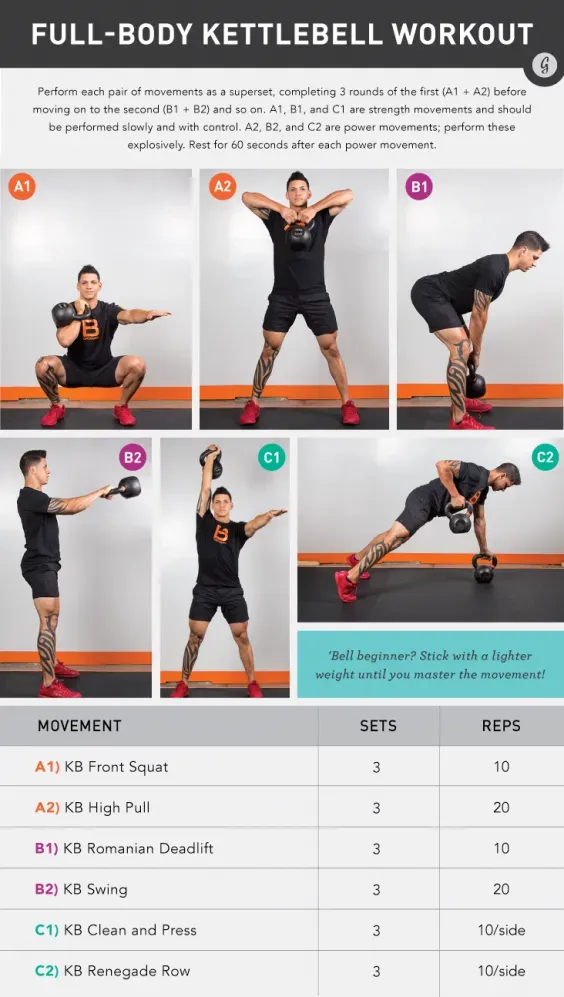Table of Contents
So, you've seen those cannonball things with handles and thought, "What the heck do I do with that?" Or maybe you picked one up, tried a swing that felt vaguely suicidal, and put it back down. Welcome to the club. Kettlebells look simple, but they demand respect and the right approach. If you're staring down a piece of iron and wondering how to get a decent workout without injuring yourself or looking like a confused circus performer, you're in the right place.
Getting Started: Why a Kettlebell Workout for Beginners Full Body?

Getting Started: Why a Kettlebell Workout for Beginners Full Body?
Ditching the Gym Crowds for One Simple Tool
Look, hitting the gym can be a hassle. Parking wars, waiting for machines, the general *vibe*. What if you could get a killer workout, hitting every major muscle group, with just one piece of equipment? That's where a kettlebell workout for beginners full body comes in. It’s portable, versatile, and frankly, looks pretty cool sitting in your living room corner. You don't need a dedicated home gym or a ton of space. A small patch of floor is usually enough. It’s efficient, cuts down on excuses, and gives you a level of functional strength you just don't get from sitting on a leg press machine.
Why Full Body is Your Best Starting Point
As a beginner, your body needs to learn how to move as a unit, not just isolated parts. A full body routine teaches coordination and builds a balanced foundation. Kettlebells are perfect for this because their design naturally encourages multi-joint movements. Think about it: a swing isn't just a back exercise; it involves your hips, core, shoulders, and grip. A goblet squat works your legs and core while you stabilize the weight. This integrated approach burns more calories, improves overall athleticism faster, and reduces the chance of developing muscular imbalances right out of the gate.
- Builds functional strength for everyday life
- Improves cardiovascular fitness
- Increases coordination and balance
- Efficiently works multiple muscle groups at once
- Requires minimal space and equipment
More Than Just Swinging Iron
Some people see a kettlebell and only think "swings." While the swing is foundational, a good beginner full body routine involves more than that. You'll press it overhead, squat with it, row it, and maybe even carry it. These movements aren't just about lifting weight; they teach your body how to brace, how to hinge properly, and how to generate power from your hips. Getting the technique right is key, and it’s surprisingly intuitive once you understand the basics. It’s about control and tension, not just brute force. This isn't some fleeting fitness fad; kettlebell training has been around for ages for a reason – it simply works.
Essential Moves for Your Kettlebell Workout for Beginners Full Body

Essential Moves for Your Kettlebell Workout for Beginners Full Body
Squatting Low with the Goblet Squat
Alright, first up in your kettlebell workout for beginners full body is the goblet squat. This is your bread and butter for lower body strength and mobility, and the kettlebell position just makes it feel right. You hold the kettlebell by the horns (the sides of the handle) against your chest, like you're holding a giant, heavy wine glass. This position helps keep your torso upright and encourages a good squat depth. Think about sitting back into a chair, keeping your chest up and core tight. Don't let your knees cave in. It's way more forgiving than a barbell squat for learning the movement pattern, and it torches your quads, glutes, and even your core because you have to work to stay stable.
Mastering the Hinge with Swings or Deadlifts
Next, we tackle the hinge. This is arguably the most important movement pattern to learn with a kettlebell, and it's crucial for a solid kettlebell workout for beginners full body. You've got two main options here: the kettlebell deadlift or the two-hand swing. For absolute beginners who are still figuring out how to push their hips back without rounding their back, the deadlift is a safer starting point. Stand with the kettlebell between your feet, hinge at your hips (like you're trying to touch a wall with your butt), grab the handle, and stand up tall by squeezing your glutes. Keep your back flat, always. The swing is more dynamic, a powerful hip snap that drives the bell forward, not lifted with your arms. Get the deadlift right first, then maybe think about the swing. Either way, you're building a seriously strong posterior chain.
- Goblet Squat: Builds lower body strength and core stability.
- Kettlebell Deadlift: Teaches proper hip hinge, strengthens back and glutes.
- Kettlebell Swing: Develops explosive hip power (once deadlift is solid).
- Focus on form over weight, always.
Picking Your First Kettlebell and Avoiding Common Beginner Mistakes

Picking Your First Kettlebell and Avoiding Common Beginner Mistakes
What Weight Won't Make You Cry?
Alright, let's talk turkey about weight. Staring at a rack of kettlebells can feel like choosing a fight you're not ready for. Go too heavy, and you're risking injury and terrible form. Too light, and you're basically doing cardio with a paperweight. For a kettlebell workout for beginners full body, the sweet spot is usually lighter than you think for ballistic moves like swings, but maybe a little heavier for grinding moves like squats and presses. A common starting point? Women often begin with 8kg (around 18 lbs) or 12kg (around 25 lbs). Men might start with 12kg or 16kg (around 35 lbs). This allows you to learn the movements correctly without getting immediately crushed. You can always go up, but you can't undo swinging something too heavy with a rounded back.
Cast Iron or Fancy Plastic? And What About the Handle?
You'll see different kinds of kettlebells out there. The standard cast iron ones are usually just fine for beginners. Some have a painted finish, others are bare metal. Bare metal can offer better grip, especially if your hands get sweaty, but might need occasional chalk. Competition kettlebells are all the same size regardless of weight, which is great for consistency but unnecessary when you're just starting out. Focus on the handle. It should feel smooth, not rough or uneven, which can tear up your hands. It should also be wide enough for both hands if you plan on doing two-hand swings. A good quality cast iron bell from a reputable brand is a solid investment that will last forever.
- **Weight:** Start lighter than you think (8-12kg for women, 12-16kg for men).
- **Material:** Standard cast iron is perfect.
- **Handle:** Look for a smooth, comfortable handle wide enough for two hands.
- **Don't skimp:** Cheap kettlebells often have rough handles or poor balance.
Rookie Errors to Sidestep
Everyone messes up when they start. It's part of the deal. But some mistakes can really set you back or get you hurt during your kettlebell workout for beginners full body. The biggest one? Using your arms to lift the weight, especially in swings. The power comes from your hips, remember? Another classic is rounding your back during deadlifts or swings – keep that spine neutral! Don't rush through reps; focus on controlling the weight, not just moving it. And please, for the love of your feet, make sure you have enough space around you. Dropping a kettlebell on your toes is a quick way to end your workout plans for a while. Start slow, prioritize form, and don't be afraid to watch some technique videos.
Beyond the Basics: Progressing Your Full Body Kettlebell Routine

Beyond the Basics: Progressing Your Full Body Kettlebell Routine
Alright, you've nailed the goblet squat without tipping over, your deadlifts feel solid, and those swings are starting to look less like a frantic bell-waving exercise and more like actual movement. So, what's next for your kettlebell workout for beginners full body? You don't stay a beginner forever, thankfully. Progression isn't just about grabbing the next size up, though that's definitely part of it. It's about challenging your body in new ways. Maybe you add a few more reps to each set, or squeeze in an extra set. Perhaps you increase the weight slightly, but only if your form stays crisp – never sacrifice technique for ego. You could also introduce variations of the exercises you know, like a single-leg deadlift or a push press instead of a strict press. Or, start looking at new movements entirely, like cleans or snatches, but maybe get some coaching for those first.
Ready to Swing? Wrapping Up Your Beginner Kettlebell Journey
Alright, you've taken the first step. You've got the basics of a solid kettlebell workout for beginners full body down. Remember, nobody expects you to look like a seasoned pro on day one. This is about showing up, practicing the fundamental movements, and gradually building strength and coordination. That kettlebell sitting there isn't just a paperweight anymore; it's a tool. Use it consistently, focus on form over lifting heavy too soon, and don't get discouraged if it feels awkward at first. Stick with these core ideas, and you'll be well on your way to making the kettlebell a powerful part of your fitness routine. Now, go get swinging.